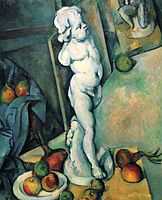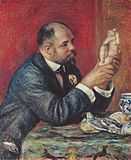Dod Procter
| Dod Procter | |
|---|---|
| Birth name | Doris Margaret Shaw[1] |
| Born |
1890 Hampstead, London, England |
| Died |
1972 Redruth, Cornwall, England[2] |
| Spouse | Ernest Procter |
| Nationality | English |
| Field | Painting |
| Training | Forbes School, Atelier Colarossi |
| Elected | President of St Ives Society of Artists (STISA) |

Dod Procter RA (born Doris Margaret Shaw, 1890–1972) was an English artist, and wife of artist Ernest Procter.[3] Her painting, Morning, was bought for public consumption by the Daily Mail in 1927.[4]
Procter and her husband attended art schools in England and in Paris together, where they were both influenced by Impressionism and Post-Impressionism movements. They also worked together at times, sometimes sharing commissions and other times showing their work together in exhibitions. Procter was a lifelong artist, active after the untimely death of her husband in 1935. She was a member of several artists organizations, such as the Newlyn School and became President of St Ives Society of Artists (STISA) in 1966. Her work was exhibited at the Royal Academy on many occasions.
Personal life and education
Doris "Dod" Shaw was born in Hampstead, London in 1890. At the age of 15 she moved to Newlyn with her mother and brother so that she could study at the Forbes School. The Shaws stayed with two other Forbes students, Dod's cousin Cicely Jesse and another woman artist, Tennyson Jesse, at Myrtle Cottage.[3] At Forbes Miss Shaw met her future husband Ernest Procter; They were "were amongst the Forbes' star pupils."[5][6]
In 1910 and 1911 Dod Shaw and Ernest Procter studied in Paris at Atelier Colarossi. Dod and Ernest were both influenced by Impressionism and Post-impressionism and the artists that they met in France, such as Pierre-Auguste Renoir and Paul Cézanne. In 1912 the couple married at Paul Church. One year later their son Bill was born.[3][5][7]
- Influential artists' works
-

Paul Cézanne, Paul Alexis reading to Émile Zola
1869–1870
São Paulo Museum of Art -
.jpg)
Pierre-Auguste Renoir, Girl Braiding Her Hair (Suzanne Valadon), 1885
-

Still Life with Cherub
1895
Courtauld Institute Galleries, London -

Pierre-Auguste Renoir, Portrait of Ambroise Vollard, 1908
They stayed in Paris until 1918,[8] during the war Ernest served in France working for the Friends' Ambulance Service.[7] Newlyn was Proctor's home for most of her working life.[4] Ernest's died unexpectedly while travelling in 1935. Three years later Dod moved to be closer to her friend Althea Garstin. After Ernest's death, Procter travelled to the United States, Canada, Jamaica and Africa. She died in 1972 and is buried next to her husband at St Hilary Church.[3][7]
Career
After the war, Dod and Ernest Procter returned to Newlyn.[7][8] Dod and Ernest accepted a commission to decorate the Kokine Palace in 1919 and 1920.[3][7][8] The Procters created designs for etched crystal.[3] From around 1922, Proctor painted a series of simplified, monumental images of young women of her acquaintance.[4] They were typified by the volume of the figures, brought out by her use of light and shadow.[4]
When her painting, Morning, in this series, was displayed at the 1927 Royal Academy Summer Exhibition, it was voted Picture of the Year and bought by the Daily Mail for the Tate gallery, where it now hangs.[9] Proctor sold the work for £300, but could have achieved ten times that amount.[10] Prior to its permanent home in the Tate, its popularity resulted in its showing in New York, and then a two year tour of Britain.[4]
Both public and critics responded to its "sensuous but sombre style" which evoked the west Cornish "silver light".[10] Frank Rutter, art critic of The Sunday Times, said in 1927 that Morning was "a new vision of the human figure which amounts to the invention of a twentieth century style in portraiture"[11] and "She has achieved apparently with consummate ease that complete presentation of twentieth century vision in terms of plastic design after which Derain and other much praised French painters have been groping for years past."[12] The model for the work was a Newlyn fisherman's 16 year old daughter, Cissie Barnes.[4]
The subjects of her pictures are largely portraits and flowers.[13] Althea Garstin's influence was realized in Procter's work in the latter part of her career. She became a full member of the Royal Academy in 1942. Three years later she illustrated A Penny for a Guy for Clare Collas. During her travels to Jamaica in the 1950s she painted made several works of children.[3]
During her lifetime and after her death her work fell out of favour.[14]
Selected paintings
|
|
Membership
She was a member or affiliated with the following organizations:[3]
|
|
Exhibitions
|
Her works were exhibited:[3]
|
Posthumous:[3]
|
References
- ↑ http://www.findmypast.co.uk/search/all/results?recordCount=-1&forenames=doris&_includeForenamesVariants=on&surname=shaw&_includeSurnameVariants=on&fromYear=1890&toYear=1890®ion=&county=&mothersMaidenName=&_useMothersMaidenNameAsSurname=on&sortOrder=RK%3Atrue&_performExactSearch=on&event=B&recordType=ALL&route=
- ↑ http://www.findmypast.co.uk/search/all/results?recordCount=-1&forenames=Doris+Margaret&_includeForenamesVariants=on&surname=procter&_includeSurnameVariants=on&fromYear=1972&toYear=1972®ion=&county=&dobYear=&dobYearTolerance=2&sortOrder=RK%3Atrue&_performExactSearch=on&event=D&recordType=ALL&route=
- ↑ 3.0 3.1 3.2 3.3 3.4 3.5 3.6 3.7 3.8 3.9 Dod Proctor Cornwall Artists. 3 October 2012.
- ↑ 4.0 4.1 4.2 4.3 4.4 4.5 "Dod Proctor", Tate. Retrieved on 16 September 2009.
- ↑ 5.0 5.1 Ernest Procter. Brown University, The Modernists Journal Project. Retrieved 3 October 2012.
- ↑ Ernest Proctor. Penlee House Gallery and Museum. Retrieved 3 October 2012.
- ↑ 7.0 7.1 7.2 7.3 7.4 Ernest Procter. Cornwall Artists. Retrieved 2 October 2012.
- ↑ 8.0 8.1 8.2 Ernest Procter Art Magick. Retrieved 3 October 2012.
- ↑ Company, Houghton Mifflin (2003), The Houghton Mifflin dictionary of biography, p. 1241, ISBN 978-0-618-25210-7
- ↑ 10.0 10.1 Koenig, Rhoda. "More than a one-hit wonder", The First Post, p. 2. Retrieved 8 February 2010.
- ↑ King, Averil. Apollo, "An exotic awakening", 1 January 2006. Retrieved from findarticles.com (registration required), 8 August 2008.
- ↑ Lang, Elsie M. British Women in the Twentieth Century, Kessinger Publishing, 2003. ISBN 0-7661-6115-3, ISBN 978-0-7661-6115-3
- ↑ King, Averil (2005), Newlyn Flowers : The Floral Works of Dod Procter, RA. Philip Wilson Publishers, ISBN 0-85667-604-7
- ↑ James, Alison (2007). A Singular Vision: Dod Procter 1890-1972, Sansom & Company Ltd. ISBN 1-904537-78-2
Further reading
- Cross, Tom (1996) Shining Sands: Artists in Newlyn and St Ives 1880-1930. Lutterworth Press. ISBN 0-7188-2925-5
External links
- Dod Proctor's work at the Tate gallery
- BBC Your Paintings: works by Dod Procter in public British collections
- A description of Morning from The World's Famous Pictures by Martin Conway and Charles J. Holmes
|